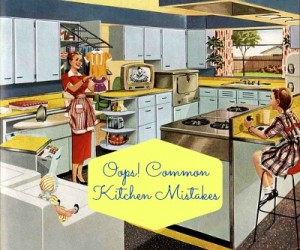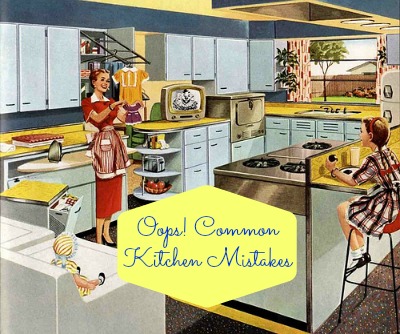By Lisa Egan
Unless you are a seasoned pro or cooking expert, chances are you have fallen for some of the most common kitchen-related myths. Some of these mistakes can result in disappointing results, some can simply cause frustration, and some can be dangerous.
Here, 15 of the most common kitchen mistakes people make:
1) Adding salt to water to make it boil faster.
Adding a big spoonful of salt to a pot of water will increase the boiling point – by four hundredths of a degree! So adding salt to water will not cook your pasta faster – unless your watch is calibrated in microseconds, says Dr. Karl of ABC Science [2].
An exception here is boiling pasta. Add salt to the water as it is coming to a boil – this is NOT to speed up cooking (as mentioned above), but to season the pasta. While cooking, the pasta will absorb the salt. A common professional recommendation is to use 1 tbsp of salt per quart of water.
2) Salting water for boiling or steaming corn.
Use unsalted water [3] to cook corn – salted water can make corn tough and shriveled. Salt your corn to taste after it is cooked.
*Bonus tip – to make removal of silk easier, wipe down corn with a wet paper towel before cooking.
3) Storing coffee in the refrigerator or freezer.
From the National Coffee Association [4]:
It is important not to refrigerate or freeze your daily supply of coffee because contact with moisture will cause it to deteriorate. Instead, store coffee in air-tight glass or ceramic containers and keep it in a convenient, but dark and cool, location. Remember that a cabinet near the oven is often too warm, as is a cabinet on an outside wall of your kitchen if it receives heat from a strong afternoon or summer sun.
4) Using hot water from the tap for coffee-making and cooking.
Use cold water when you brew coffee. It’s better for your machine and the flavor is typically better because cold water contains fewer minerals. Oh, and if you are using tap water for coffee-making or any kind of cooking, it is especially important to use cold water to avoid or reduce lead exposure [5] (the warmer the water, the more lead it will contain if you have lead in your pipes). If your water has been off for more than six hours, run your high-volume taps on COLD for at least five minutes (including those in your showers). Run your kitchen tap on cold for at least 1-2 additional minutes. Boiling water does not reduce lead contamination.
5) Believing that sharper knives are more dangerous than ones that are dull.
The truth is, you are more likely to cut yourself with a dull knife. Here’s a brilliant explanation from Home Ec 101 [6]:
Think about cutting a firm, slippery object such as an apple. When the smooth edge of a knife is applied to the slick surface of the apple one of two things will happen: either the blade of the knife will skid along the surface of the fruit or it will cut into the flesh. A dull knife is more likely to slip rather than cut. Once the knife has slipped it is a matter of luck and reflexes where the business end goes.
When cutting items a sharp knife requires much less pressure to cut into an item. When combines with a reduced tendency to slip, this gives a cook greater control over the blade.
6) Avoiding the use of soap on cast iron cookware.
While placing cast iron cookware in the dishwasher is not recommended, it is fine to use a little bit of mild dish soap on a well-seasoned pan. Use cold water, and don’t scrub the cookware with a scouring sponge or steel wool. If you want to remove sticky residue, you can rub kosher salt on the pan and then re-season it by heating it in a warm oven and rubbing it with oil, says George Duran, Chef Ambassador for the cookware company IMUSA [7]. No matter how you wash your cast iron pans, remember not to let them air dry, as this can cause rust to form.
Speaking of pans…
7) Overcrowding pans with food.
Overcrowding does not allow steam to escape as food releases moisture. Don’t pile your pieces of food on top of each other – spread them out on your cooking surface. If you are cooking large volumes and want to save time, use two pans.
8) Using the wrong amount of water to cook rice.
If your rice is turning out sticky and gummy (and you don’t like it that way), it’s probably because you are using either too much or too little water. Not having enough water in the pot means can make the grains rub against each other and release starch, making rice sticky. Using too much water can also make rice clumpy because it sits in the water it doesn’t absorb. Try using 1.5-1.75 cups of water per cup of rice. Brown rice will usually require a bit more water, and shorter-grain rice will likely require a little less. Best bet? Use a rice cooker – they consistently cook rice just right.
9) Adding oil to water to prevent pasta from sticking.
It’s a common belief that adding olive oil to a pot of pasta water will prevent the water from boiling over and will stop the pasta from turning into a big sticky blob. Using oil can prevent sauces from sticking to your pasta.
Here’s why:
Since oil is less dense than water and is composed of hydrophobic molecules, it creates a layer across the top of the water. When the pasta is drained, it is poured through this oiled layer and leaves a fresh coat of oil on the pasta. (source [8])
Instead of dumping oil in the pot, be sure to use enough water – pasta expands while cooking, so fill a 6-8 quart pot about 3/4 of the way full with water. Remember to use cold water.
Also, don’t rinse your pasta after cooking – doing so removes a lot of the starch, which contributes flavor to pasta and helps makes sauces stick.
10) Not cold-plunging eggs after hard-boiling them.
When eggs are dropped into boiling water, the whites are cooked faster than the yolk. By the time the yolk is done, the whites are overdone. The result? Rubbery whites or yolks with a green ring around them. To avoid this, plunge eggs in cold water to stop the cooking process.
*Bonus tip – try hard-cooking eggs instead of hard-boiling. Bring a pot of eggs and cold water to a slight boil, then turn off the heat. Cover the pot, let the eggs sit for about 10 minutes, and plunge them in cold water.
11) Softening butter for baking recipes in the microwave.
Microwaves can heat unevenly, resulting in half-melted or over-softened butter. This presents a problem for some baked goods – for example, it can make your cookies flatten.
It’s better to let your butter stand at room temperature for 30 to 45 minutes to get the right consistency. You can speed the process significantly by cutting butter into tablespoon-sized portions and letting it stand at room temperature. Properly softened butter should yield slightly to gentle pressure.
Oh, and recipes that call for room temperature butter often turn out better with room temperature eggs – let them sit in a bowl of warm water until they are no longer cool to the touch (usually about 5 minutes).
12) Not cooling vegetables when they’ve reached the desired texture.
Hard-cooked eggs aren’t the only food that needs a bit of a cool-down after cooking. After you boil veggies like green beans, broccoli, or asparagus, they should have a nice vibrant green color and crisp-tender texture. But if you don’t “shock” them with cold water to stop the cooking process, you’ll end up with brownish-green mush. Plunge your cooked veggies into ice water (or at least, under cold running water) to help them hold their pretty color and ideal texture.
13) Throwing berries in baggies and freezing them.
If you toss raspberries, blueberries, strawberries, and other delicate berries into a bag to freeze them, you’ll likely end up with a mushy mess when you thaw them.
Here’s how to avoid that problem: wash and dry your berries and spread them in a single layer on a baking sheet. Place it in the back of your freezer. This way, each individual berry is frozen, instead of being formed into an icy clump with its neighbors. After the berries are frozen, you can transfer them to baggies to store them.
*Bonus tip – don’t wash berries until you are ready to eat or freeze them. Moisture is their enemy, and washing them prematurely can make them mold or rot faster.
Did you know that the white coating on blueberries [9] is called bloom and that it that protects them from the elements? Washing it off leaves them more vulnerable.
14) Keeping an open box of baking soda in the fridge to absorb odors.
Baking soda does not absorb bad smells very well at all, according to this scientist [10]:
The popular “open box of Arm & Hammer in the refrigerator” simply provides an adsorbent material that can soak up odors — but not very effectively. For example, if some of the odoriferous materials floating around in the refrigerator are acidic, the alkaline baking soda can absorb and neutralize the acid. Even in that regard, it is not all that effective because, as the powder in the box contacts water vapor, it tends to crust over an lose a great deal of its already limited surface activity.
Activated charcoal [11] works better. It can be purchased at stores that sell aquarium or plant and garden supplies. Place activated charcoal or activated carbon in a shallow bowl in your refrigerator.
15) Avoiding seeds in peppers because that’s where the “heat” is.
Lifehack [12] explains:
Capsaicin (8-methyl-N-vanillyl-6-nonenamide) can be found anywhere in fruits that hold it (yes, chili peppers are fruits), but the highest concentration is actually in the placental layer of the fruit, the white flesh. Seeds have very little of it, actually, the heat comes from capsaicin that adheres to the outside of the seeds when the white flesh is cut.
*Bonus tip – drinking water won’t stop your mouth from burning from hot peppers, but yogurt, ice cream, or milk will. The reason? Capsaicin is not water-soluble [13] – it dissolves in oils and fats, though.
16) Over-mixing dough and batters.
Unless a recipe says to knead dough vigorously, always mix dough and batters gently and carefully. Fold just until ingredients are blended together – mixing too much or too roughly can result in rubbery pancakes and tough bread.
Hopefully, these tips and tricks will help your time in the kitchen be more efficient and safe.
Do you have any additional tips or tricks to share? Please feel free to do so in the comments!

